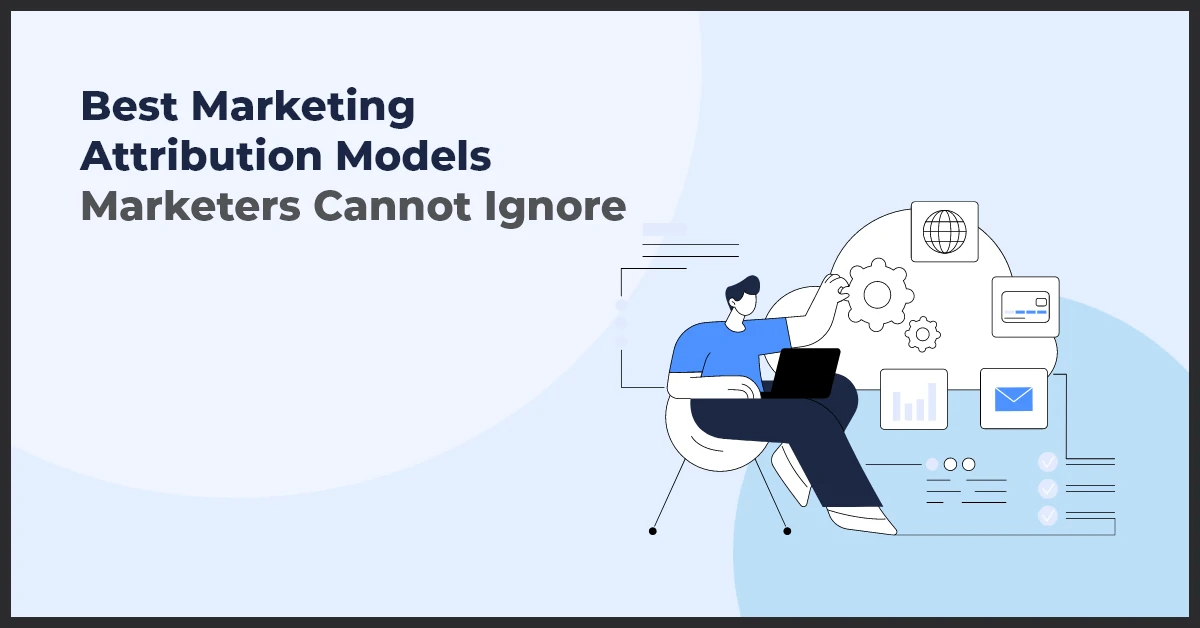Best Marketing Attribution Models Marketers Cannot Ignore

Published on: April 12, 2022
Updated on: September 26, 2024
1070 Views
- Digital Marketing
14 min read
A customer’s journey and interaction with a business isn’t necessarily a straight path. Since brands use multiple marketing channels to target customers, the path to product discovery, engagement, and transactions can be unique to each customer. For instance, a customer may discover your brand on a billboard, recall it on social media, research about your products on your website, and shop the product on Amazon!
So, which of these touchpoints influenced your customer the most to buy your product?
As a marketer, it is important to know which of your marketing campaigns are driving the maximum sales. At the same time, you must also identify the laggers and push them toward success. Marketing attribution models can answer the questions you have regarding the performance of your different marketing campaigns.
Unlocking the Power of Marketing Attribution Models: Your Map to Customer Journey Success
Hey there, fellow marketing enthusiasts! Are you ever curious about the secret forces at work behind the scenes of every sale and conversion? Let's demystify one of marketing's most important concepts: attribution. Simply put, attribution in marketing is like being a detective. It's the art (and science) of tracking down which adverts, campaigns, or touchpoints deserve a tip of the hat for influencing a customer's decision to buy or engage with your brand.
But what's a touchpoint, you ask? Imagine a breadcrumb trail, with each crumb being a point of interaction - an email, a social media ad, maybe a high-five with your brand (figuratively speaking)—that a customer encounters on their journey. Touchpoints are those crucial moments when a customer engages with your brand, shaping their experience and perception.
Figuring out which touchpoint—or combination of touchpoints—clinched the deal is no small feat. This is where the brilliance of Marketing Attribution Models shines! By understanding each channel's role in the sales process, we can allocate resources more effectively, refine our strategies, and ultimately give credit where credit is due. So, are you ready to follow the breadcrumb trail to uncover the true heroes of your marketing story? Let's dive in!
A Guide to Common Attribution Models
Unlock the potential of every marketing touchpoint with an in-depth look at common attribution models. By understanding how each model works, you can better determine the success of your digital marketing efforts and make smarter business decisions. Let’s dive into the most widely-used attribution models and discover how they can inform your marketing strategy.
2.1 First-Click Attribution
First-Click Attribution shines the spotlight on customer journey beginnings. This model assigns full credit to the very first interaction a customer has with your brand. If you value initial awareness over other points in the sales pipeline, First-Click Attribution might be your go-to model for identifying which channels are best at starting customer conversations.
2.2 Last-Click Attribution
Last-Click Attribution gives all the glory to the final touchpoint before a conversion happens. It’s simple and straightforward—whatever the potential customer engaged with last gets the credit for their action. Despite its focus on the endgame, this model might overlook the efforts of all the other marketing tactics that warmed up the lead along the way.
2.3 Linear Attribution
Linear Attribution is the egalitarian choice in the world of marketing attribution models. It spreads the love evenly, attributing equal credit to each touchpoint a customer has encountered. If you’re all about fair credit distribution and want a holistic view of the entire customer journey, this might just be your attribution model soulmate.
2.4 Time Decay Attribution
The Time Decay model takes a more nuanced approach. It’s all about giving more weight to interactions that happen closer to the conversion point. It respects the journey but gives a nod to the fact that the finishing steps may have more influence in nudging the customer over the finish line.
2.5 U-Shaped (Position-Based) Attribution
The U-Shaped Attribution model is a bit of a standout, focusing on the pivotal roles of lead generation and conversion. It attributes significant credit to both the first interaction and the point of conversion, while sprinkling the remainder across other touchpoints. Think of it as recognizing the importance of a strong first impression and a compelling closing argument in your marketing narrative.
2.6 W-Shaped Attribution
For those who appreciate complexity, W-Shaped Attribution elevates the game by thickening the plot. This model highlights three critical touchpoints: initial engagement, lead creation, and conversion. By giving special attention to these significant interactions, it recognizes multiple pivotal moments that collectively drive the purchase decision.
2.7 Data-Driven (Algorithmic) Attribution
Data-Driven Attribution is like the AI whiz-kid of attribution models, smartly allocating credit where it’s due by harnessing machine learning and big data. This model tailors the attribution to your unique marketing scenario, sifting through loads of data to determine which touchpoints truly hold sway over your customers’ decisions.
In the quest for perfect attribution, each model offers a different lens through which to view your marketing effectiveness. Consider your goals, your customer's journey, and the data you have on hand when deciding which model aligns best with your strategy. Now let’s explore how these models function in real-world scenarios, and how you can apply them to maximize your marketing success.
Advanced Attribution Methods: Navigating the Nuances of Modern Marketing
As we venture deeper into the world of marketing attribution, we encounter sophisticated techniques that provide nuanced insights into the customer journey. These advanced methods go beyond the basics, offering a more comprehensive understanding of how each touchpoint influences a customer's decision to convert. Let's dive into some of the cutting-edge attribution models that marketers are using to optimize their strategies.
3.1 Multi-Touch Attribution (MTA)
We begin with Multi-Touch Attribution (MTA), an approach that acknowledges the complexity of modern consumer interactions. Unlike models that credit a single touchpoint, MTA considers each step in the marketing funnel, attributing value to multiple touchpoints along the buyer's journey. This comprehensive approach captures the multifaceted nature of how marketing efforts contribute to conversions, allowing businesses to make more informed decisions about where to allocate their resources.
3.2 Cross-Channel Attribution
Then, there's the intricate world of Cross-Channel Attribution. With consumers engaging with brands via multiple platforms – from social media to search engines to email campaigns – mapping out a unified view of the conversion path becomes complex. Cross-channel attribution tackles this by tracking interactions across different channels and devices, piecing together a complete picture of how these interwoven elements play a role in the final purchase decision.
3.3 Custom Attribution Models
Every business is unique, and sometimes the one-size-fits-all approach doesn't capture the intricacies of a company's marketing dynamics. That's where Custom Attribution Models come into play. These models are tailored to fit a business's specific needs, allowing for flexibility in defining what success looks like. Custom models enable marketers to pinpoint the effectiveness of their campaigns with greater precision, leading to more strategic and targeted marketing efforts that drive better results.
3.4 Machine Learning in Attribution
Lastly, let's talk about the role of Machine Learning in elevating attribution models to new heights. As the name suggests, machine learning algorithms learn from data to make predictions or decisions without being explicitly programmed to perform the task. In the context of attribution, machine learning can analyze vast amounts of marketing data, uncovering patterns and insights that would be impossible for humans to discern. This leads to predictive attribution models that are continuously improving, providing marketers with forward-looking insight to shape future strategies.
Embracing these advanced attribution methods is essential for marketers who wish to stay ahead in a digital landscape that's constantly evolving. By leveraging the power of comprehensive data analysis and acknowledging the rich complexity of consumer behavior, businesses can truly optimize their marketing efforts to achieve remarkable success.
The Challenges of Measuring Attribution
Putting a lens on how we assess marketing impact reveals a myriad of complexities. While the quest for the ultimate attribution model continues, there are specific obstacles that remain prevalent. Today, let's navigate through the winding path of measuring attribution and examine the challenge it brings to marketers.
4.1 Online vs. Offline Attribution
While digital footprints are easier to track, the real conundrum arises when trying to account for offline interactions. How do we connect an in-store purchase to a digital ad someone viewed weeks ago? Bridging the gap between online and offline channels is often akin to piecing together a puzzle without all the pieces. We're navigating in a realm where customer journeys interweave between the digital maze and the physical world, where tracking every touchpoint is not always possible.
4.2 Privacy and Data Collection
Consumer privacy has stepped into the limelight, and rightly so. With regulations like GDPR and CCPA reshaping the landscape, acquiring granular data without breaching trust has become a tightrope walk for marketers. The shift towards privacy-centric marketing means we need to re-evaluate our approach to data collection, ensuring that it is ethical, transparent, and complies with the ever-evolving legal standards.
4.3 Challenges in Attribution Modelling
Even with the best tools at hand, attribution modeling is fraught with hurdles. Let's unfold a few:
- Multi-touch attribution can be complex and resource-intensive, demanding significant data processing and analysis.
- There's often a lack of consensus on which model best represents the customer journey, creating a subjectivity in model selection.
- The digital marketing environment is perpetually evolving, making it hard for static models to keep pace with new channels and consumer behaviors.
These bottlenecks in measuring marketing effectiveness are testaments to the nuanced nature of attribution. It's a dynamic puzzle that demands constant innovation and adaptation. Nevertheless, understanding these challenges is the first step in creating a more accurate and holistic view of marketing performance.
Tools of the Trade: Navigating Marketing Attribution with the Right Software
5.1 Attribution Software and Tools
Embarking on the journey of marketing attribution requires not just knowledge, but also the right set of tools. Let's introduce some of the leading software solutions that have become indispensable for tracking and analysis.
- Google Analytics: A powerhouse in tracking website traffic and user behavior, Google Analytics plays a pivotal role in the attribution space.
- Adobe Analytics: For those who need in-depth analysis and customization, Adobe Analytics offers advanced features suited for detailed attribution modeling.
- Bizible: It unifies data from multiple touchpoints to deliver omni-channel attribution insights, catering specifically to marketers.
- Attribution: As the name suggests, this platform provides real-time insights into the performance of every marketing touchpoint.
These tools are just the tip of the iceberg, but they provide a solid foundation for businesses seeking to implement effective marketing attribution models.
5.2 Integration with Marketing Analytics
While having robust attribution tools is key, the true magic happens when they're perfectly blended with your overall marketing analytics strategy. The integration of attribution tools with marketing analytics ensures a seamless flow of data across platforms, providing a holistic view of the customer journey.
With this integration, organizations can unlock valuable insights into which marketing efforts are driving conversions and, more importantly, why. This enables marketing teams to make informed decisions and optimize campaigns for maximum impact. The beauty of a well-integrated system is that it transforms raw data into actionable intelligence.
Whether it's understanding the performance of a multi-channel campaign or justifying the allocation of your marketing budget, the right attribution tools integrated with your analytics will guide your marketing endeavors towards success.
Maximizing ROI with Attribution Models
As the linchpin of astute marketing strategies, the ability to maximize ROI—not just measuring it—is crucial for businesses seeking sustainable growth. Let's unpack how attribution models can become your secret weapon for boosting Return on Investment.
Understanding Return on Investment (ROI)
Return on Investment, or ROI, stands as one of the most significant metrics in the marketing realm. It’s the compass that guides marketers to make data-driven decisions that validate the cost-effectiveness of their campaigns. ROI quantitatively measures the profitability of investments compared to their cost, emphasizing why it's a cornerstone in evaluating the impact of marketing efforts.
Connecting Attribution to ROI
Attribution models serve as pivotal tools for dissecting the paths customers take to conversion. By assigning value to each marketing touchpoint, businesses can accurately assess which channels are genuine performance powerhouses. This direct linkage between attribution modeling and ROI enables marketers to strategically allocate budgets and fine-tune campaigns for enhanced profitability and efficiency.
Client Case Studies
Nothing speaks louder than success stories. Various enterprises have reaped the rewards of meticulously implemented attribution models:
- A retail conglomerate remodeled its marketing strategy based on multi-touch attribution insights, leading to a 50% surge in e-commerce ROI within a single quarter.
- An international SaaS provider, wrestling with lead quality, embraced a lead attribution setup and witnessed a startling 80% improvement in lead conversion rates, driving up ROI exponentially.
- A local boutique chain shifted to a data-driven attribution approach, uncovering previously underestimated social media influence, resulting in tripling its campaign ROI year-over-year.
These case studies exemplify the transformative impact that informed attribution modeling can have on a business's bottom line. By peeling back the layers of marketing data, companies can identify high-yield strategies and amplify their Return on Investment to new heights
Looking Ahead: The Future of Marketing Attribution
As we fast forward into a digitally-transformed future, the world of marketing attribution is poised to hit new strides and adapt to the shifting landscapes of consumer behavior and technological innovation. It's an ongoing journey with a horizon that's always evolving. So, what can we expect when gazing into the crystal ball of marketing attribution?
Predictions and Trends
Attribution models aren't just about looking back; they're set to be dynamic guides for the future. As machine learning and artificial intelligence continue to advance, they will likely become integral parts of attribution solutions, offering even deeper insights into customer behavior and predictive analytics.
- Granular Real-Time Data: The ability to track and analyze actions at micro-levels in real time will enable marketers to make agile decisions.
- Cross-Device Attribution: With individuals hopping between devices, seamless cross-device tracking will become more sophisticated.
- Privacy-Centric Models: With increasing privacy concerns and regulation, attribution models will have to adapt to a world with less granular data but broader behavioral patterns.
Preparing for Changes
Change is the only constant, and for marketers, being prepared is half the battle won. How can you future-proof your strategies and ensure that your marketing attribution efforts remain ahead of the game?
- Invest in Agility: Flexibility in tools and strategies will allow you to pivot quickly as new technologies and platforms emerge.
- Understand Privacy Regulations: Stay informed about global privacy rules and adapt your attribution models to ensure compliance.
- Continuous Learning: The digital marketing landscape is forever changing; ongoing education and adapting to new trends will be pivotal.
Embracing these future-facing approaches will not only help you navigate the forthcoming tides of marketing attribution but also solidify your role as a forward-thinking marketer. Remember, the future of marketing attribution is as much about embracing new methodologies as it is about anticipating and responding to the ever-evolving customer journey.
Wrapping It Up: The Power of Accurate Marketing Attribution
Marketing Attribution Models are more than just buzzwords—they are pivotal in understanding the customer journey and making data-driven decisions to optimize marketing strategies. Remember that the key to successful marketing attribution is selecting the right model for your unique business needs and analyzing the outcomes to constantly improve your efforts.
Embrace Effective Attribution for Better Results
By adopting and integrating appropriate attribution models, you can precisely evaluate the impact of each touchpoint in your marketing funnel. This approach allows you to distribute your budget more effectively, enhancing the overall return on investment (ROI) for every marketing dollar spent.
Never Settle: The Cycle of Analysis and Adaptation
Marketing is an ever-evolving landscape. Thus, embracing ongoing analysis and adaptation in your attribution methods is integral. As you gather data, be prepared to refine your strategies to stay ahead of trends, technologies, and consumer behavior changes.
Take the Next Step in Your Attribution Journey
If you're ready to get serious about marketing attribution and want to see tangible results, subscribing to our insights is a great starting point. But if you're looking for tailored solutions, our team is on standby to craft bespoke attribution modeling services that resonate with your unique business challenges. Dive deeper into the world of attribution with us and watch your marketing strategies transform with precision and efficacy.
- Subscribe now for more in-depth insights into cutting-edge marketing strategies.
- Contact us directly to discuss customized attribution modeling that aligns with your specific goals.
Don't miss an opportunity to enhance your marketing effectiveness. Act now and make marketing attribution work to your advantage!
Frequently Asked Questions
Learn about different marketing attribution models, which are frameworks for determining how credit is assigned to marketing channels or touchpoints along the customer journey. Common attribution models include first touch, last touch, linear, time decay, and U-shaped (or position-based) models.
Marketing attribution is the process of identifying and assigning credit to different marketing channels and touchpoints that contribute to a customer’s conversion or purchase. It helps marketers understand the effectiveness of their campaigns and optimize their strategies.
Marketing attribution is important because it provides insights into which marketing efforts are driving conversions and revenue. This helps marketers allocate their budgets more efficiently, optimize campaigns, and improve ROI by focusing on the most effective channels.



